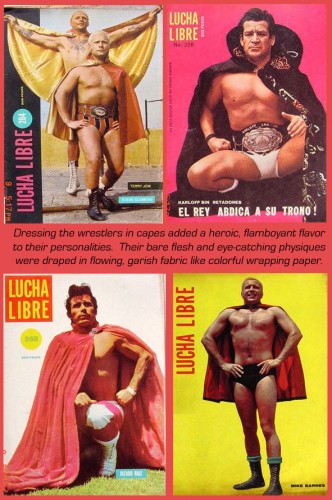 Last week, we analyzed Lucha Libre magazines from the 1960’s and their celebration of hyper-masculinity, aggression and strength depicted in the thick bodies featured on the covers. But I’ve noticed that some of the Lucha Libre magazine covers have a different tone and feel, and seem to send a different message.
Last week, we analyzed Lucha Libre magazines from the 1960’s and their celebration of hyper-masculinity, aggression and strength depicted in the thick bodies featured on the covers. But I’ve noticed that some of the Lucha Libre magazine covers have a different tone and feel, and seem to send a different message.
Dressed provocatively in their flamboyant robes and satin capes, often in traditionally effeminate colors of red, yellow, or pink (or posed in front of backgrounds featuring these colors), some of the rough, tough macho men appear to be more into fashion than fighting. They seem to be trying to capture the male gaze using provocative poses and colorful costumes. The images take on a homo-erotic tone when you consider that most of the people buying the magazines and enjoying the posed bodies and campy costumes are also men. This is far different from our usual understanding of the “macho” Luchadore and homophobic fans.
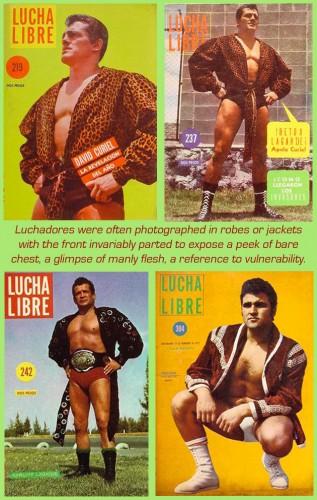 Mexican culture, which celebrates maschismo, tends to deny the existence of homosexuality, or to rail violently against the very notion of a dude being attracted to another dude. The term “maricon” was coined as a derogatory word meaning homosexual or queer. One writer describes this word as:
Mexican culture, which celebrates maschismo, tends to deny the existence of homosexuality, or to rail violently against the very notion of a dude being attracted to another dude. The term “maricon” was coined as a derogatory word meaning homosexual or queer. One writer describes this word as:
“Possibly the worst insult that one can lob at a Latino male is the dreaded M-word. To call someone a “maricon” is to take the nearest English equivalent (“faggot”), triple its intensity, add several layers of hatred and disgust, and square the result. In my generation at least, nobody jokes about this word or uses it lightly.
So why did the “macho” Mexican wrestling fans in the 1960’s apparently 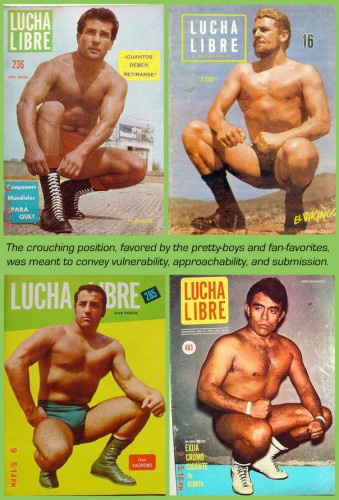 accept (or perhaps were drawn to) the frequent images of clearly handsome men photographed in revealing or flamboyant clothing, striking provocative beefcake poses on the cover of the wrestling magazines?
accept (or perhaps were drawn to) the frequent images of clearly handsome men photographed in revealing or flamboyant clothing, striking provocative beefcake poses on the cover of the wrestling magazines?
Judging from these photos, the best-looking, prettiest Mexican beefcake was dressed in beautiful garments and robes that a Drag Queen would be proud to own (or was stripped nearly naked until you could barely see if he was wearing trunks) and posed in submissive, kneeling positions to convey vulnerability and weakness.
Perhaps the manly Mexican wrestling fans are not as purely “macho” and hetero as they let on. (Methinks they protest too strongly.) These magazine covers and the popularity of Lucha Libre as a sport seem to indicate that a good share of the population likes to look at pretty, sexually appealing, fantastically dressed men (not that there’s anything wrong with that!)
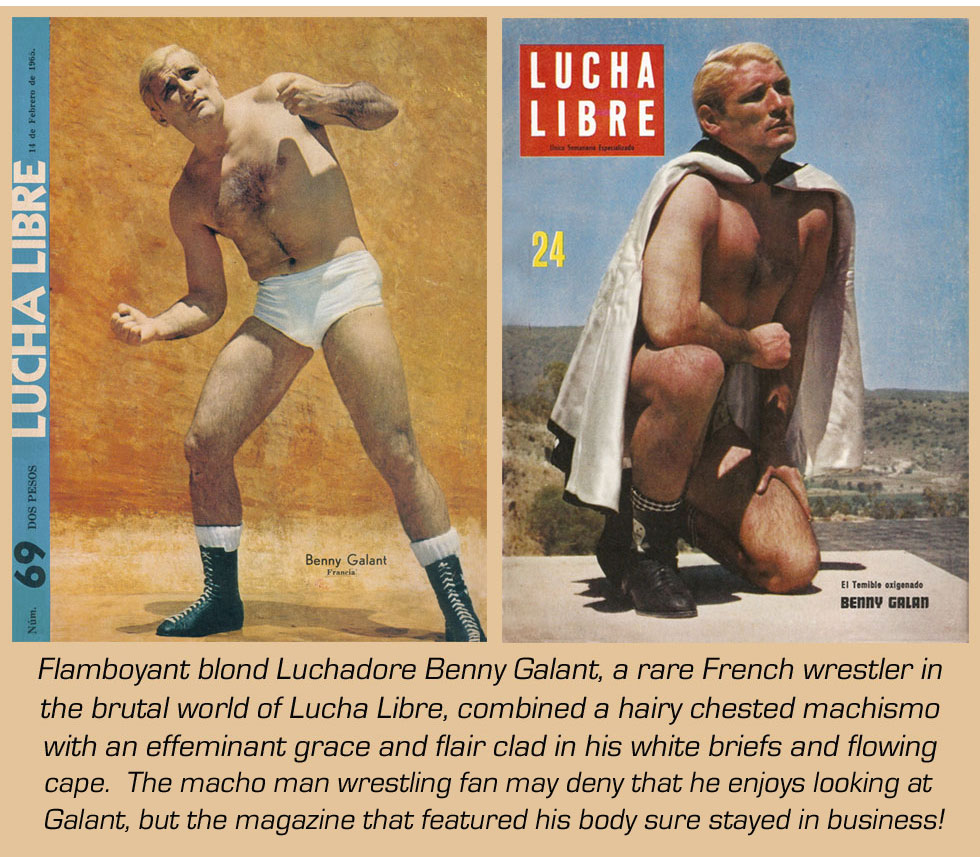
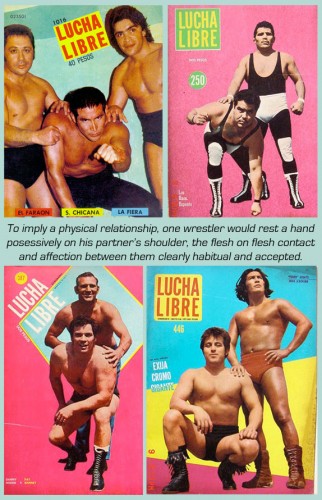 When Tag Teams or groups of wrestlers appear on the magazine covers, there was often physical contact between the partners. Ironically, despite all the hang-ups about machismo, Mexican culture allows for more touching, hugging, hand-holding and other physical displays of affection in public between presumably hetero males.
When Tag Teams or groups of wrestlers appear on the magazine covers, there was often physical contact between the partners. Ironically, despite all the hang-ups about machismo, Mexican culture allows for more touching, hugging, hand-holding and other physical displays of affection in public between presumably hetero males.
Therefore, when a Tag Team was posed for their cover photos, the male bonding (and the hint of a possible physical attraction) that existed between the partners was not denied as you might expect in a hyper-masculine society. Instead, the men were pictured proudly touching their partners, a hand resting on the bare flesh of his shoulder or back, and the partner receiving the affectionate touch willingly allowing it.
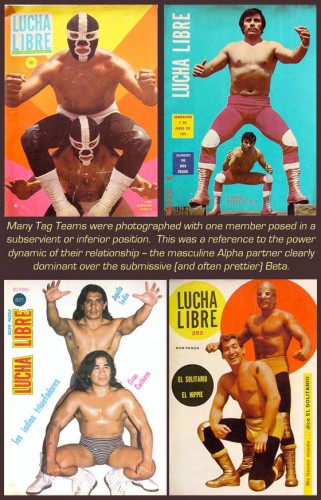 Many Tag Team photos also depict a dominant and submissive relationship between the partners — the stronger man appearing above, or physically towering over, the weaker partner. American tag teams are usually depicted as twins or brothers — exact matches for each other. Mexicans (with their cultural focus on macho control and domination) prefer to see Tag Team partners depicted as husband and wife — each man’s status in the relationship clearly represented.
Many Tag Team photos also depict a dominant and submissive relationship between the partners — the stronger man appearing above, or physically towering over, the weaker partner. American tag teams are usually depicted as twins or brothers — exact matches for each other. Mexicans (with their cultural focus on macho control and domination) prefer to see Tag Team partners depicted as husband and wife — each man’s status in the relationship clearly represented.
It’s interesting to note that, if two men in Mexico do have a sexual encounter, only the submissive or “bottom” is considered the Maricon. The dominant man — the penetrator — is given a pass for his homosexual tryst, or even gains Macho cred due to his unquenchable sexual prowess and ability to control and compel another man to his bidding.
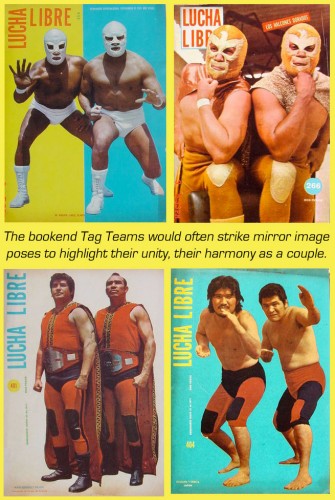 One of the hallmarks of Lucha Libre is the wearing of brightly colored, strikingly beautiful costumes meant to highlight the wrestlers’ bodies and capture the interest and attention of the fans. There aren’t many places a man can dress this flamboyantly except maybe at Mardi Gras, a gay pride parade, and in the wrestling ring.
One of the hallmarks of Lucha Libre is the wearing of brightly colored, strikingly beautiful costumes meant to highlight the wrestlers’ bodies and capture the interest and attention of the fans. There aren’t many places a man can dress this flamboyantly except maybe at Mardi Gras, a gay pride parade, and in the wrestling ring.
The full color photos on the cover of the magazines definitely celebrated these bright, intense colors — probably to catch the eye of the shopper and encourage purchase of the magazine (similar to the way toy and cereal manufacturers use bright primary colors.) A tag team could double the intensity of the effect by wearing matching gear, both donning the same wild colors to underscore their bond and partnership.

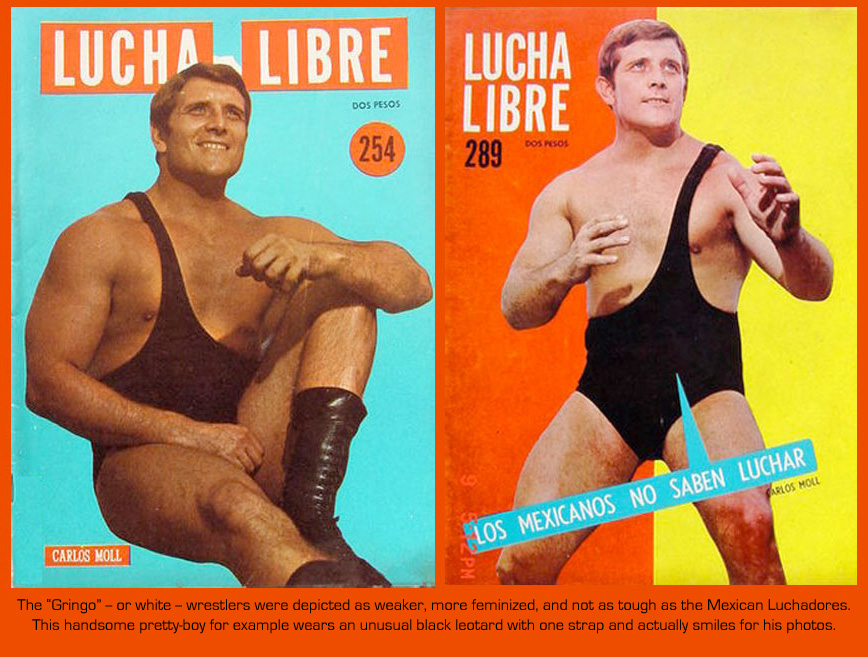
Hey Arsenal, I found this entry about these old-school Mexican magazines to be very interesting… I know I would buy these mags if they were still being published … Also want to mention all of your current October posts have been well done and very interesting, so kudos!
Thanks For Posting,
Ray
Just a note: The worst word for insulting a gay man is PUTO, not maricon. Maricon just means acting girly, therefore you can be str8 and maricon. Also, nowadays lots of young str8 man bother each other using that word, is not considered anymore as a BIG INSULT. “Puto” would be worse, but anyways they use that aswell, lol.
Another thing: the title should be “maricones” not maricons, for pluralize, you add ES